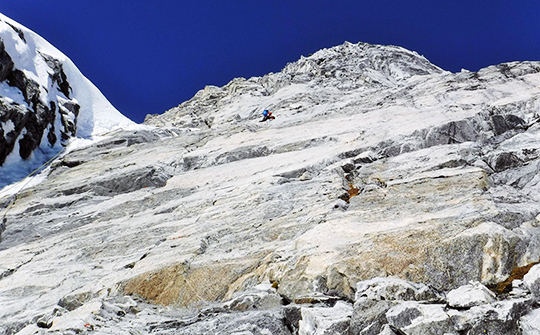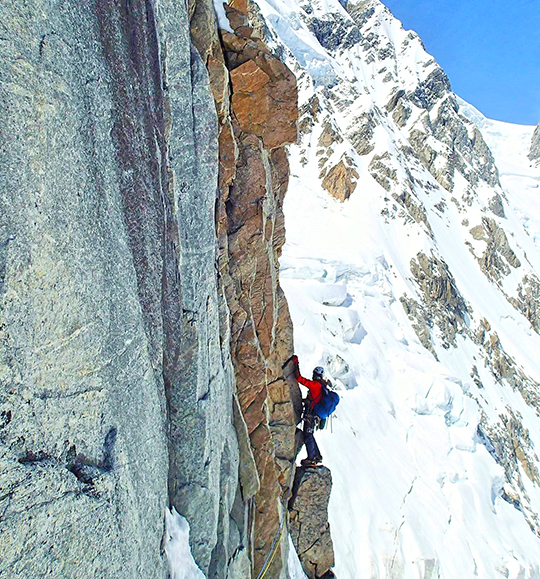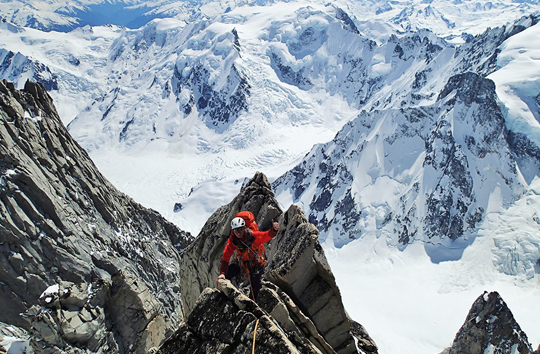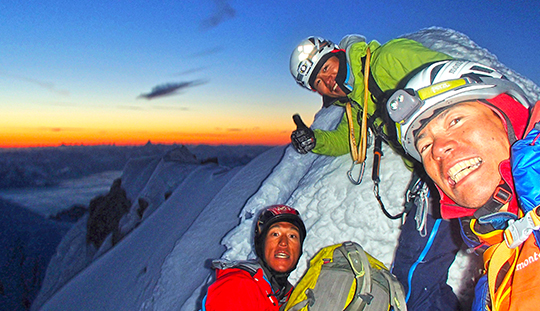
[Photo] Takeshi Tani
May 2, Waddington Range, B.C., “Watch out!” Toshiyuki Yamada yelled down to Noboru Kikuchi and me as he triggered a wet avalanche. The three of us were descending Bravo Peak (3105m) after completing a two-day ascent of Floydesque (ED1 5.8 WI4, 880m, Stanier-Kay, 1995) on the north face of the mountain.
We were nearly fifty meters from the glacier at the base of the wall when the slide happened.
I firmly planted an ice axe into the snow slope and braced for impact. The slide ripped Noboru from his stance. Since we were all tied in together, we were all dragged down. I remember rolling. It all happened so fast. I felt helpless.
We fell nearly 50 meters, and stopped three meters from a crevasse. We were tangled in the rope, snow was forced down our clothing, but no one appeared injured.
This was our warm-up climb for our primary objective: a traverse of the Waddington Range starting at Rainy Knob (1860m) to the Plummer Hut via Mt. Waddington (4019m), Combatant (3756m), Tiedeman (3848m), Asperity (3716m) and Seras (3642m). Some of these red-granite walls have faces that are greater than 2000 meters in height.

[Photo] Toshiyuki Yamada
The full range traverse is from Furry Gap to Plummer Hut, but we wanted to begin at Rainy Knob because it is the perfect spot for alpine climbing and we planned to stay in the area for a month.
[To read more about the first solo ascent of the Waddington Range traverse in summer, read “Mt. Waddington to Asperity Mountain, high peaks solo traverse; first solo ascents,” by Colin Haley, in the American Alpine Journal–Ed.]
A few hours after the avalanche, once the adrenaline wore off and we were settled in base camp, we made light of our situation and laughed uncomfortably. We knew how close we’d come. Then Toshiyuki said his back hurt but he still wanted to continue with the trip.
Southwest Face of Asperity Mountain
May 5, 4 a.m: After resting in camp for a few days, we approached Asperity Mountain to climb a new route left of the Southwest Face route (ED1 5.10+, 950m, Elson-McLane, 2010).
At sunrise, we reached the snow slope at the foot of the face that led to 150 meters of WI3. We paused at the top of the ice and took care to eye our proposed line before switching into our rock shoes and continuing on up. The face was split with sharp cracks of all sizes.
For the next eight hours we led in blocks and followed the pitches free. Most of the terrain was easier than 5.10, and we were able to keep a steady pace. As the sun began to go down we reached the base of the crux of our route. A perfect hand crack cleaved its way up the left facing corner for sixty meters. The line reminded me of Indian Creek’s Incredible Hand Crack. I couldn’t believe it. Even though there was a good bivy ledge at the base of the crack, we decided to continue on and climb the crack in last light.

[Photo] Toshiyuki Yamada
The problem with climbing the crack free was that it was cold and there was ice inside of it. By the time we finished it, our feet and hands had turned numb. On top of this section was another small ledge, which made for a good, but sloping bivy for three. We got settled at 11 p.m. under clear skies.
That night I couldn’t sleep. We were all cold, uncomfortable and excited about the next day’s climbing. We got moving at 5 a.m. and followed more cracks to reach a knife-ridge that lead to a headwall and then the summit. Once at the top of Asperity Mountain, we brewed up and prepared to descend a narrow couloir in the dark. Though we knew it would be slow going to travel at night, the threat of rockfall, seracs and avalanches would be lower than during the day.

[Photo] Noboru Kikuch
We reached the ground at sunrise after down climbing for countless hours and doing one rappel to get past a crevasse in the couloir. During the descent Toshiyuki’s back pain intensified. Though we were all tired after completing our new route, called Happy Trio (ED- 5.10a WI3, 950m), Toshiyuki was definitely in bad shape. Noboru and I considered canceling the remainder of our trip, but Toshiyuki insisted that we all stay.
For the next week, while we waited for Toshiyuki to get better, Noboru and I skied on the Upper Tellot glacier.
Bravo Route
May 16: Toshiyuki said he felt better and was ready to climb. However, by this time a storm had dumped a large amount of snow in the area and the weather was unsettled. With visibility low, we decided against taking risks skiing over crevasses that would be difficult to see.
We skied out of camp on May 22 under low visibility, set up camp at the base of the Waddington summit plateau and prepared to climb Bravo route (TD 5.7) in snowy, icy conditions. These climbing conditions reminded me of ascending Mt. Hunter in Alaska. We began the route at 4 p.m. and reached the top of the climb at 9:30 p.m. That night we stayed at upper camp on the summit plateau and rested for a day before traversing past Angel Glacier to reach the Waddington-Combatant col at 11 p.m.
While traversing the steep, avalanche-prone slopes near the Angel Glacier, Noboru suffered a knee injury from overuse. Now with two members of the team injured, we decided to cancel our goal of the traverse from Combatant to Seras. We soon descended from the Waddington-Combatant col to reach Rainy Knob and waited for the helicopter to pick us up.

[Photo] Takeshi Tani
Though we failed to complete a traverse of the Waddington Range in spring conditions, we’re happy to have completed a new route on Asperity’s southwest face.